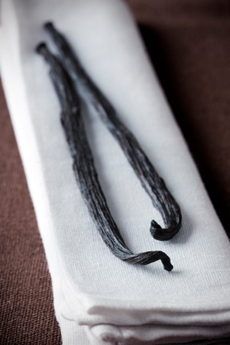
 Vanilla is the second costliest spice in the world, after saffron. Photo of vanilla beans by Joan Vicent Canto | IST.
|
|
|
MARISSA GOLDBERG is a graduate of the Institute For Culinary Education.
|
|
November 2008
Updated March 2009
|
 |
Vanilla: The World’s Favorite Flavor
Page 1a: The Vanilla Orchid
This is Page 1a of a ten-page article. Click on the black links below to visit other pages.
The Vanilla Orchid
Vanilla is the dried pod of an orchid plant; the name derives from the Spanish word vainilla, which means “little pod.” Of the many thousand species of orchids, only, Vanilla planifolia (a.k.a. Vanilla fragrans) and Vanilla tahitensis are known to bear an edible fruit.
From Mexico To The World
Because of the explosive demand for vanilla flavoring, in the 1800s, the orchid was planted on various Indian Ocean islands including Madagascar and Réunion [previously known as the Bourbon Islands  after the French Bourbon kings, and bestowing the name Bourbon vanilla]. Today, Madagascar produces most of the world’s vanilla. after the French Bourbon kings, and bestowing the name Bourbon vanilla]. Today, Madagascar produces most of the world’s vanilla.
Taken to the South Seas (notably Tahiti and Papua New Guinea), the variety evolved into Vanilla tahitensis. A third variety of bean, Vanilla pompona, grows in the West Indies, Central and South America, but is not of culinary quality. It is said to have a cherry-like aroma and is used primarily in perfume and non-food applications. Instead of looking like green beans, the pods look like miniature, four-inch-long bananas.
Above, the Vanilla planifolia orchid. You can grow vanilla orchids at home; buy the plants from HostGardns.net However, as you’ll read below, you’ll have to cure the pods yourself!
The orchids, when pollinated, sprout hanging seed pods which resemble very long  green beans. It isn’t easy to get the orchid to bear fruit: wild pollination is dependent on the whims of a particular fly and commercial cultivation requires laborious hand pollination. And, whether by fly or human hand, the flower opens for less than one day in its lifetime—often for just 5 hours in the morning! (Fortunately, the orchid plant continues to sprout new flowers.) green beans. It isn’t easy to get the orchid to bear fruit: wild pollination is dependent on the whims of a particular fly and commercial cultivation requires laborious hand pollination. And, whether by fly or human hand, the flower opens for less than one day in its lifetime—often for just 5 hours in the morning! (Fortunately, the orchid plant continues to sprout new flowers.)
Photo of vanilla pods by Alan Lagadu | IST.
Creating Edible Vanilla
When the vanilla pods are harvested, they’re of no immediate use: They have neither flavor nor fragrance. They require a long curing process to develop their characteristic black color, memorable aroma and flavor.
Considering the intensive monitoring for open blossoms to pollinate, the maturation of the vanilla pod, scalding in hot water, curing and drying in the sun, and resting to develop its aroma and flavor: Vanilla is the world’s most laborious crop to produce, and this is why vanilla beans and real vanilla extract are so expensive. No wonder so many people use artificial vanilla, created in a lab.
But, like the difference between butter and margarine, once you have tasted the real thing, you’re willing to pay the difference!
Continue To Page 2: Vanilla Glossary & Types Of Vanilla Products
Go To The Index At The Top Of The Page

|
|




 Vanilla is the second costliest spice in the world, after saffron. Photo of vanilla beans by Joan Vicent Canto | IST.
Vanilla is the second costliest spice in the world, after saffron. Photo of vanilla beans by Joan Vicent Canto | IST. after the French Bourbon kings, and bestowing the name Bourbon vanilla]. Today, Madagascar produces most of the world’s vanilla.
after the French Bourbon kings, and bestowing the name Bourbon vanilla]. Today, Madagascar produces most of the world’s vanilla. green beans. It isn’t easy to get the orchid to bear fruit: wild pollination is dependent on the whims of a particular fly and commercial cultivation requires laborious hand pollination. And, whether by fly or human hand, the flower opens for less than one day in its lifetime—often for just 5 hours in the morning! (Fortunately, the orchid plant continues to sprout new flowers.)
green beans. It isn’t easy to get the orchid to bear fruit: wild pollination is dependent on the whims of a particular fly and commercial cultivation requires laborious hand pollination. And, whether by fly or human hand, the flower opens for less than one day in its lifetime—often for just 5 hours in the morning! (Fortunately, the orchid plant continues to sprout new flowers.)